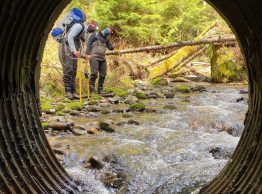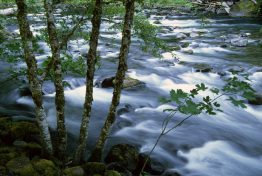The latest U.S. News & World Report listing of top-ranked universities in the world is out for 2024, and UW's marine and freshwater biology ranked No. 5 for subject rankings, and geosciences ranked No. 9. The University of Washington overall tied for No. 7 and maintained its No. 2 ranking among U.S. public institutions.
Read more at UW News »Honoring College of the Environment Class of 2024 graduates
In appreciation of their contributions to enriching our community — and based on the recommendation of our Student Advisory Council and a vote by our graduating students themselves — the College will be partnering with the Campus Sustainability Fund to help fund the UW Farm Wapato Pond project.
Read more »DNA shows where Washington culvert replacements helped spawning salmon
To help struggling salmon populations, the state of Washington is legally required to replace hundreds of culverts that divert streams under roadways. The state transportation department is replacing old, rusting metal pipes with broad, concrete promenades that provide more gradual gradients and gentler flows for salmon swimming upstream to access more spawning grounds. The full scope of the effort will last 17 years and cost $3.8 billion.
Read more at UW News »Fish, Forests and Fungi
Mushrooms have a long-standing history as a culturally and nutritionally significant food source, yet we still have much to learn about our fungal friends. Enter the wondrous world of mushrooms: some toxic, some colorful; some cap-tipped, some mimicking a wave in the ocean. Regardless of how much research has been done on fungi, we have only scratched the surface, with only four percent of fungi species characterized.
Read more »Thousands of baby sea stars born at UW lab are sign of hope for endangered species
Just a few days shy of the first day of spring, scientists at Friday Harbor Laboratories on San Juan Island had reason to celebrate. Dozens of juvenile sea stars, no bigger than a poppy seed, had successfully metamorphosed from floating larvae to mini star — the important first step toward becoming an adult. Between now and then, these sunflower sea stars, the largest sea star species in the world, will grow up to 24 arms and a colorful body the size of a serving platter.
Read more at UW News »





